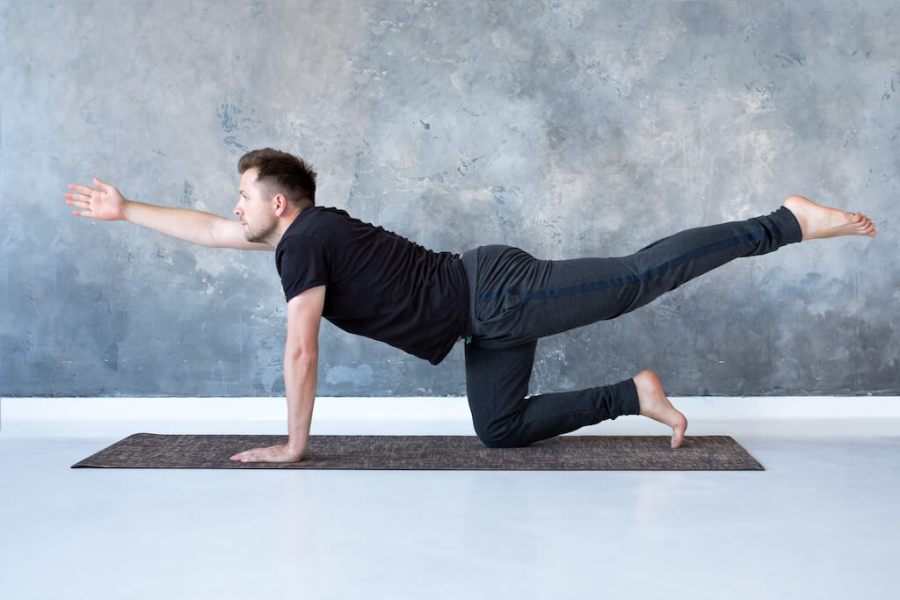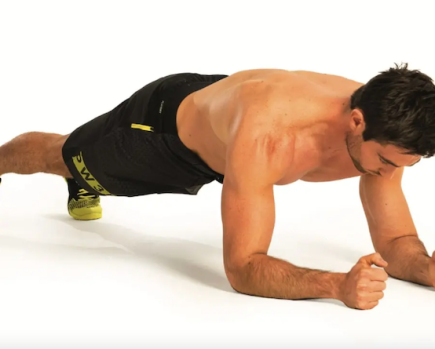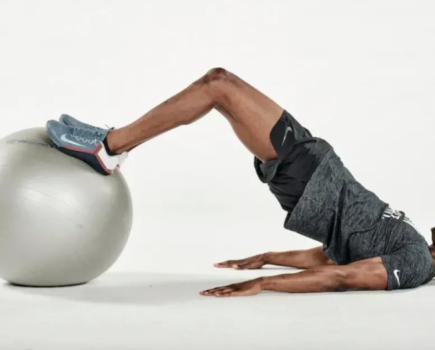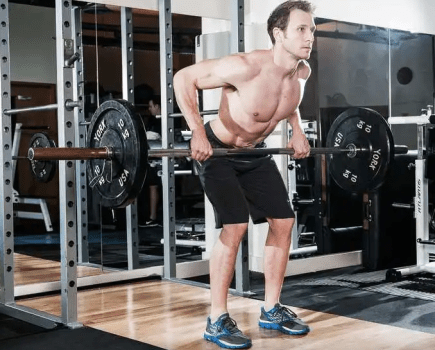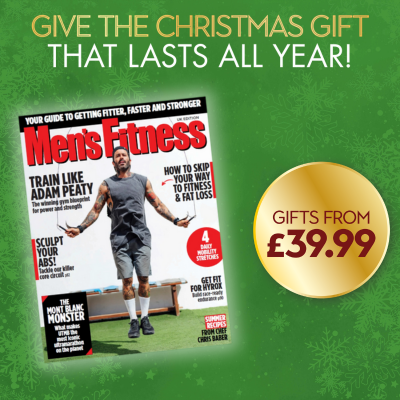The best lower back exercises are those that target the three major muscle groups and incorporate both dynamic and isometric movements.
In my experience, many gym-goers focus too much on building their ‘mirror muscles’, and too little on less glamorous but ultimately more important areas, like the lower back. The lower back refers to the region starting from the bottom of the middle back (thoracic spine) to the sacrum (the boney structure connected to the pelvis). It’s made up of a number muscles that can broadly be divided into three major muscle groups.
One group, the extensor group, works to straighten (extend) the spine, while another group, the flexor group, functions to bend (flex) the spine. Then, there is also a third group, the iliopsoas, which helps to rotate and side-bend the lower back. Together, these muscles are also important for stabilising and protecting the spine.
Two scientifically proven approaches to working the lower back are using dynamic and isometric exercises. Dynamic exercises are those that use lengthening (eccentric) and shorting (concentric) phases of muscle contraction, while isometric exercises activate muscles without changes in muscle length (no lengthening or shortening). Lower back isometric exercises are shown to not only build muscle and strength, but also to enhance spinal stiffness and stability.
I’ve gone into more detail about why it’s important to strengthen the lower back at the bottom of this page. Before then, here are the exercises I recommend.
Why you can trust us
Workout and exercise content is the cornerstone of the content we produce, and we’ve recruited some of the best personal trainers and fitness coaches in the business to produce it. These lower back exercises were pulled together by personal trainer and founder of JC Fitness, Jonathan Cooke, who’s also a Registered and Chartered Physiotherapist.
Add these lower back exercises to your strength training arsenal
- 45-degree lower back hyperextension
- Gym ball lower back hyperextension
- 45-degree side bend
- Side bridge
- Bird-dog
- Superman
- Barbell good morning
- Nordic hamstring curl
- Barbell Romanian deadlift
- Deadlift
1. 45-degree lower back hyperextension
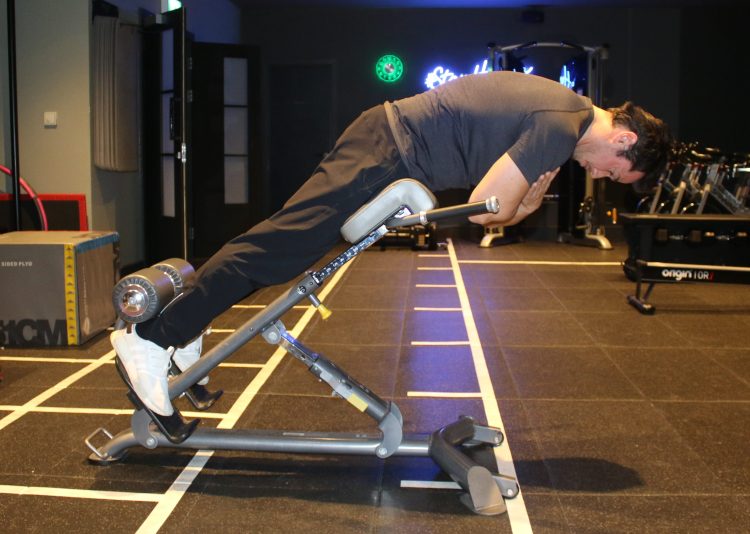

| Recommended reps | 8-12 |
| Recommended sets | 3 |
Why I like it: This is a dynamic exercise that targets the extensor group of the lower back. It enables a full range of movement for lower back flexion and extension, while working the glutes and hamstrings.
How to do it:
- First, position the bench hip rest just above the top of your pelvis
- Start with your spine in neutral and chin tucked
- Next, slowly round your lower back, but without bending at the hips
- Then, overarch (hyperextend) the lower back while lifting your head up
2. Exercise ball lower back hyperextension
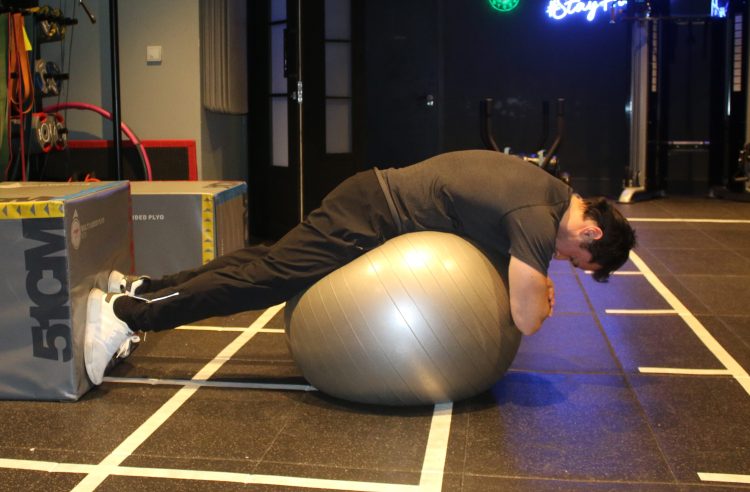
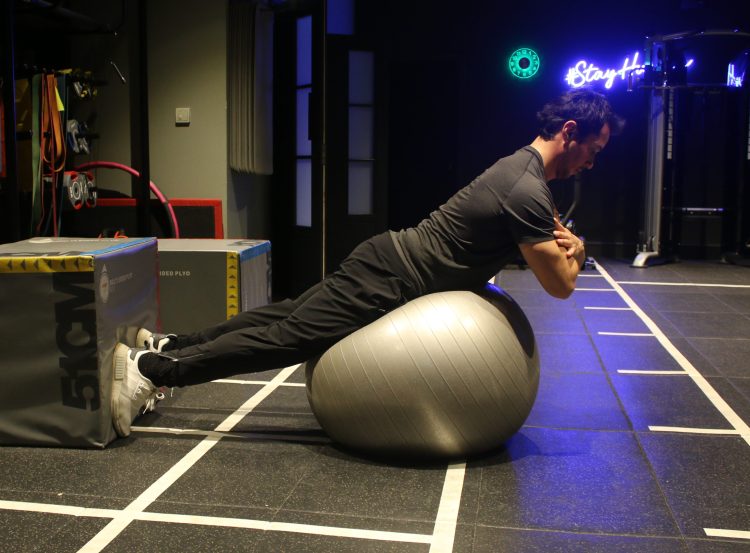
| Recommended reps | 8-12 |
| Recommended sets | 3 |
Why I like it: This is an excellent variation of the 45-degree lower back hyperextension, easily adapted to an exercise ball as an alternative. The gym ball allows for a comfortable position and works the stabilising core muscles.
How to do it:
- First, lie over the gym ball with your hips resting on the ball
- Anchor your feet under something secure to provide stability
- Start with your spine in neutral and chin tucked
- Then, slowly round your lower back over the ball until your stomach is resting on the ball
- Next, overarch (hyperextend) the lower back, lifting your stomach off the ball while lifting your head up
3. 45-degree side bend
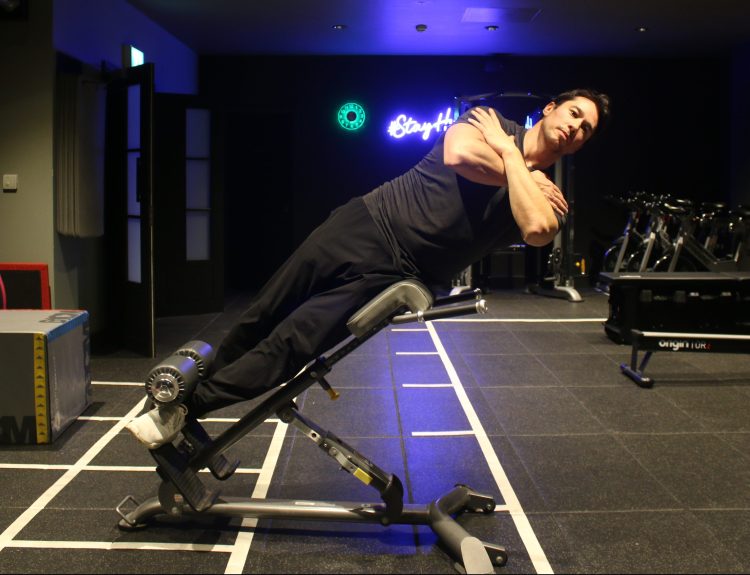
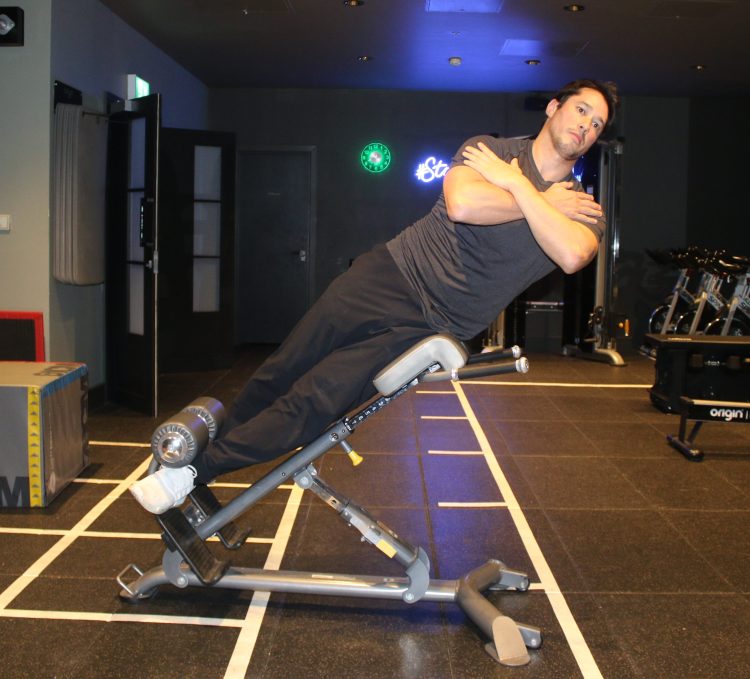
| Recommended reps | 8-12 |
| Recommended sets | 3 |
Why I like it: This a dynamic exercise that targets the iliopsoas side-bending muscle group of the lower back. The 45-degree back extension helps anchor the hips and legs, while allowing for a full range of side-bending movement at the lower back, making it one of the best exercises for this region.
How to do it:
- First, scissor your legs and anchor each foot underneath the foot pads
- Now, position the bench hip rest just above the pelvis
- Start with your spine and head in neutral
- Next, lower yourself by side-bending maximally at your torso, but avoiding any forward bending
- Then, raise yourself back up to a neutral position
4. Side bridge
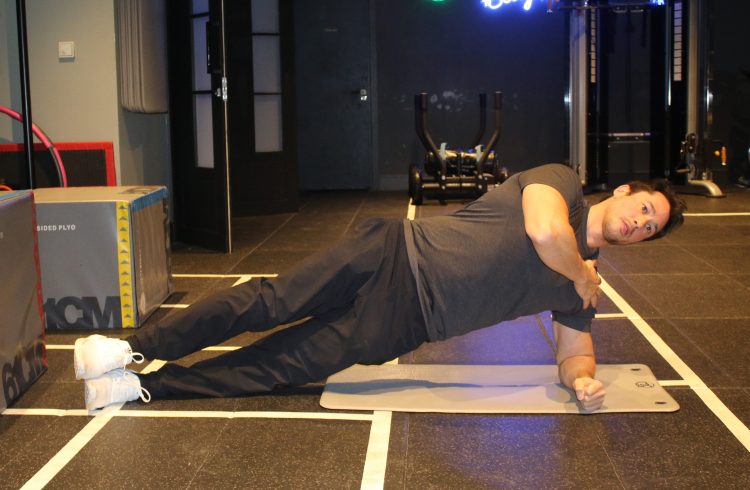
| Recommended hold time | 8-10 secs x 5 (each side) |
| Recommended sets | 3 |
Why I like it: This is an isometric exercise that also targets the iliopsoas muscle group. It not only contributes to the development of these muscles, but also enhances spinal stability.
How to do it:
- First, lie on your side with your weight on your elbow, with legs straight and feet scissored
- Rest your free arm on top of your lower shoulder
- Next, raise your hips from the ground so only your feet and arm are supporting your body
- Maintain a neutral spine and head position
- Hold this position for 8-10 seconds, then change sides
5. Bird-dog
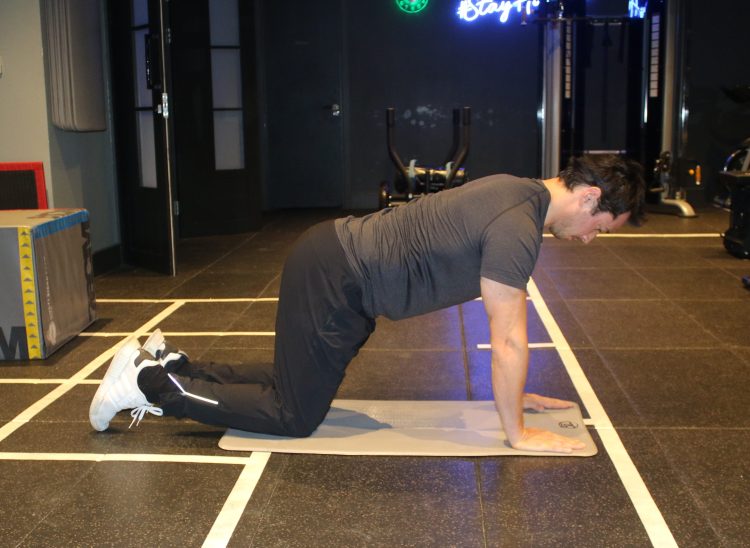
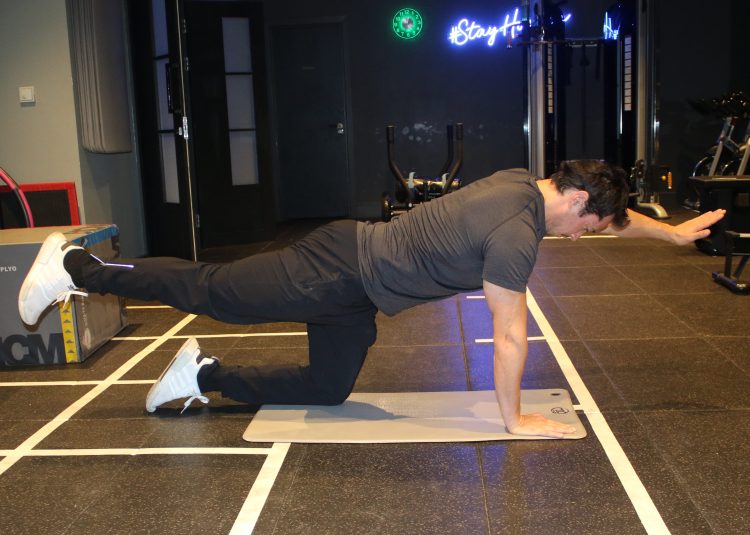
| Recommended hold time | 8-10 secs x 5 (each side) |
| Recommended sets | 3 |
Why I like it: This is an isometric exercise that challenges the extensor muscle group. It requires no equipment and is shown to be an effective exercise for developing lower back stability and endurance.
How to do it:
- First, start in the quadruped position (on hands and knees with hips and shoulders bent to about 90 degrees)
- Maintain a neutral spine
- Next, raise one leg backwards, while simultaneously raising the opposite arm until both limbs are fully straightened
- Complete the movement while maintaining a neutral spine
- Then, hold this position for 8-10 seconds, then lower back to the quadruped position and change sides
6. Superman
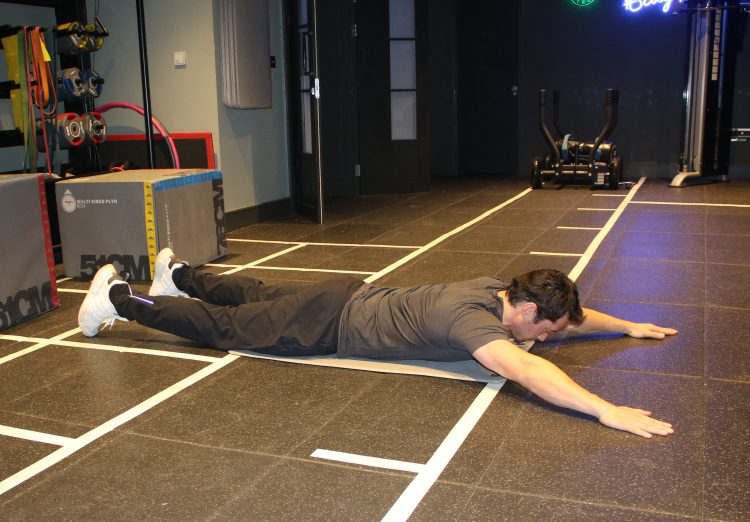
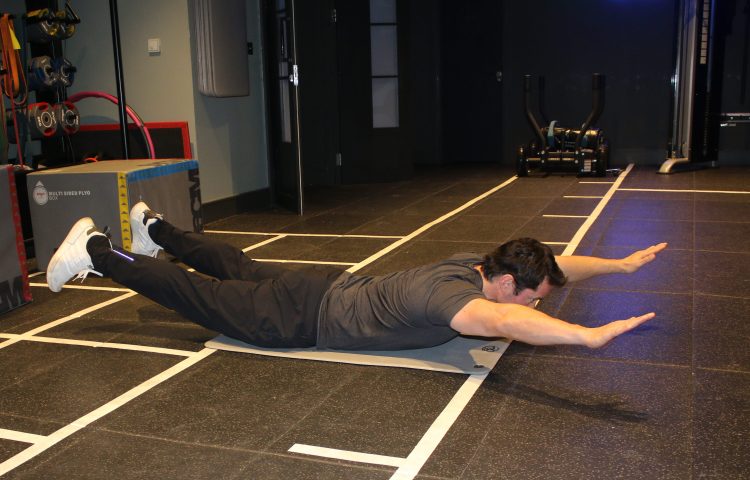
| Recommended hold time | 3-4 secs x 8-10 |
| Recommended sets | 3 |
Why I like it: This is an isometric exercise that challenges the extensor muscle group. This is one of the best exercises for the beginner to advanced lifter and is effective for developing lower back spinal stability and muscular endurance.
How to do it:
- First, lie face down on a floor with your arms outstretched overhead and legs straight
- Next, simultaneously raise both your arms and legs about 4-5 inches off the ground (simulating a flying position)
- Now, hold this position for 3-4 seconds then lower your arms and legs back to the starting position on the floor
7. Barbell good morning
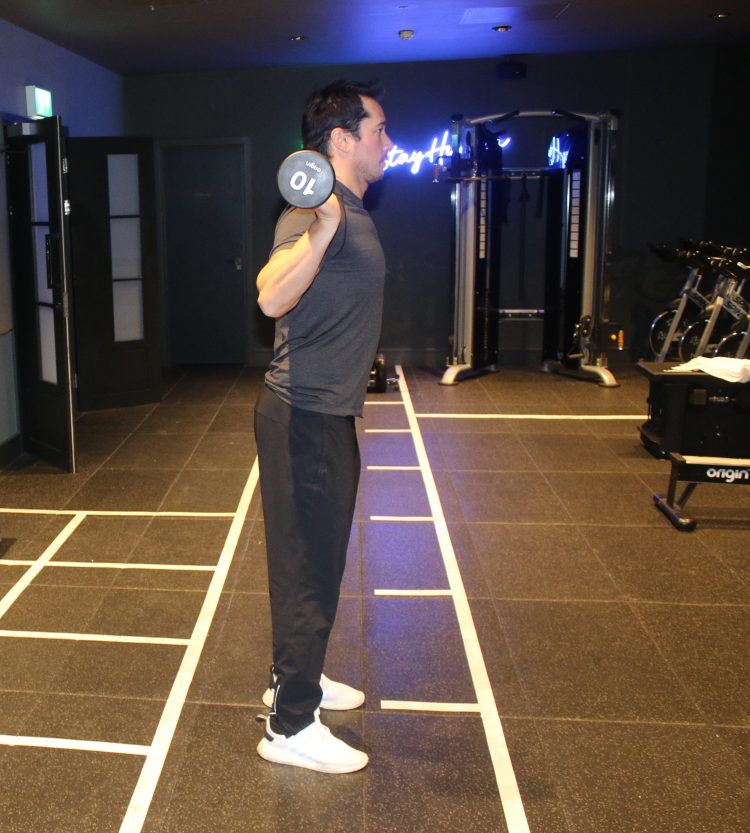
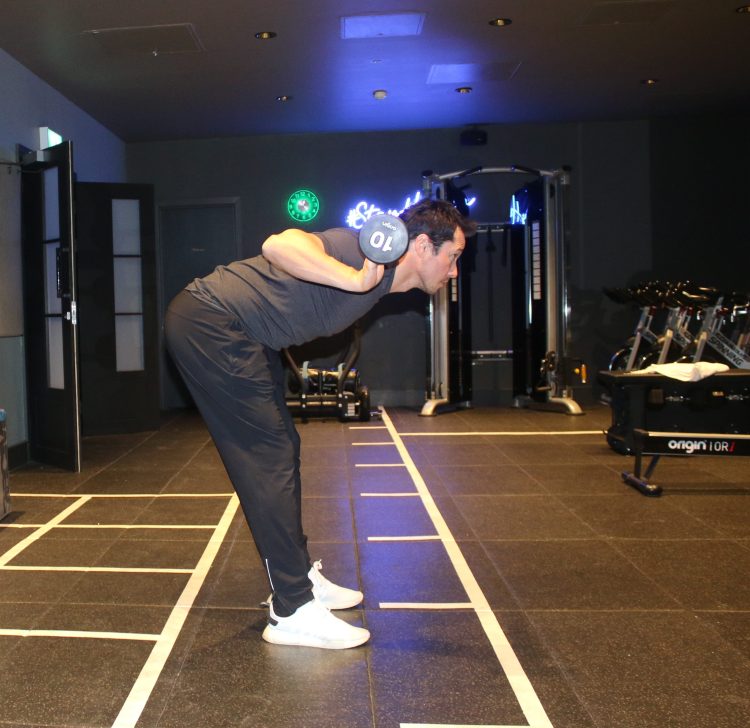
| Recommended reps | 8-12 |
| Recommended sets | 3 |
Why I like it: This exercise works the extensor group of the lower back isometrically as these muscles function in the good morning position to stabilize the spine when hinging the hips. It also works the glutes and hamstrings, as they extend (push) the hips forward through the concentric (shortening) phase.
How to do it:
- First, position a barbell on the upper trapezius muscles at the tops of your shoulders
- Then, slightly bend your knees
- Maintain a strict neutral spine with head slightly tilted upwards
- While maintaining a neutral spine, slowly hinge your hips by pushing your hips back, but without increasing the bend in your knees
- Hinge only as far as your hips travel back, avoiding any rounding of the spine or additional knee bending
- Now, push your hips forward into extension, squeezing your glutes muscles until you return to the start position
8. Nordic hamstring curl
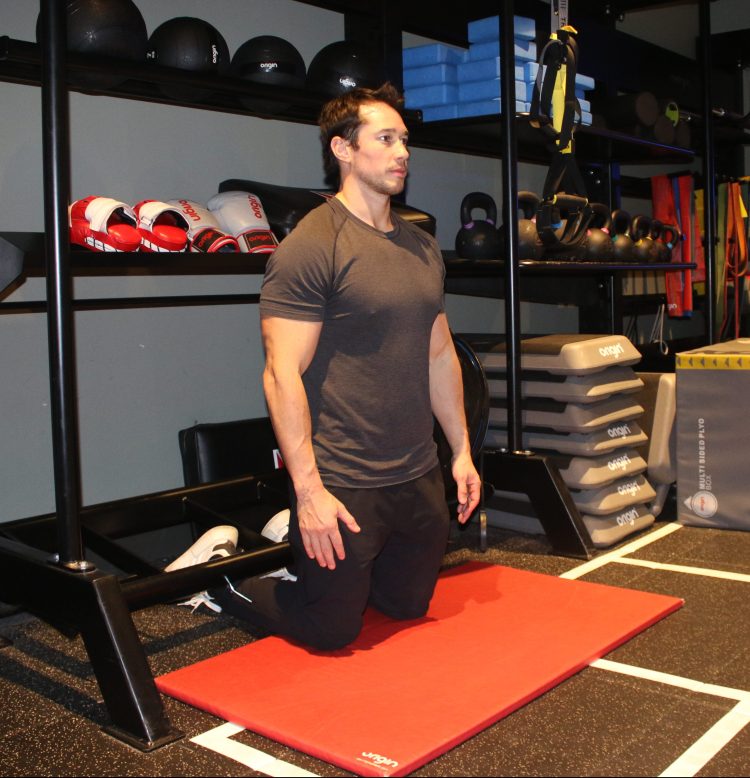
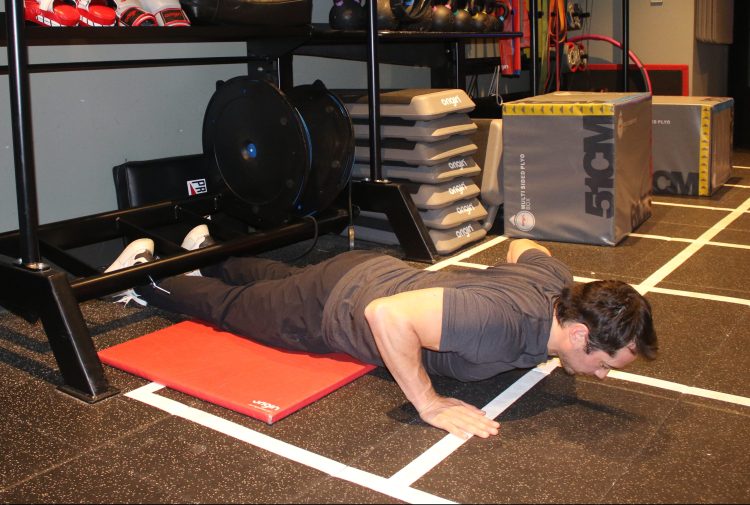
| Recommended reps | 8-12 |
| Recommended sets | 3 |
Why I like it: This is an isometric exercise that works the extensor group in the same manner as in the barbell good morning. Here the lower back muscles contract isometrically to stabilise the spine through the eccentric (lengthening) and concentric (shortening) phases of the lift. The hamstrings are also directly targeted in this exercise for their role as knee flexors.
How to do it:
- Start in a kneeling position with your torso upright and straight
- Straighten your arms in front of your body at chest height (like in a push-up)
- Now, anchor your feet under something secure to provide stability
- While maintaining a neutral spine, and with your arms outstretched in front of you, slowly lower yourself to the ground by straightening your legs (there should be no bending at your hips)
- Let your arms absorb some of the force when lowering
- Next, raise the body back to the start by bending the knees (think about kicking your heels to your butt)
- If needed, to assist the hamstrings on the concentric (lifting) phase push the floor away with your arms (like in a push-up)
9. Barbell Romanian deadlift
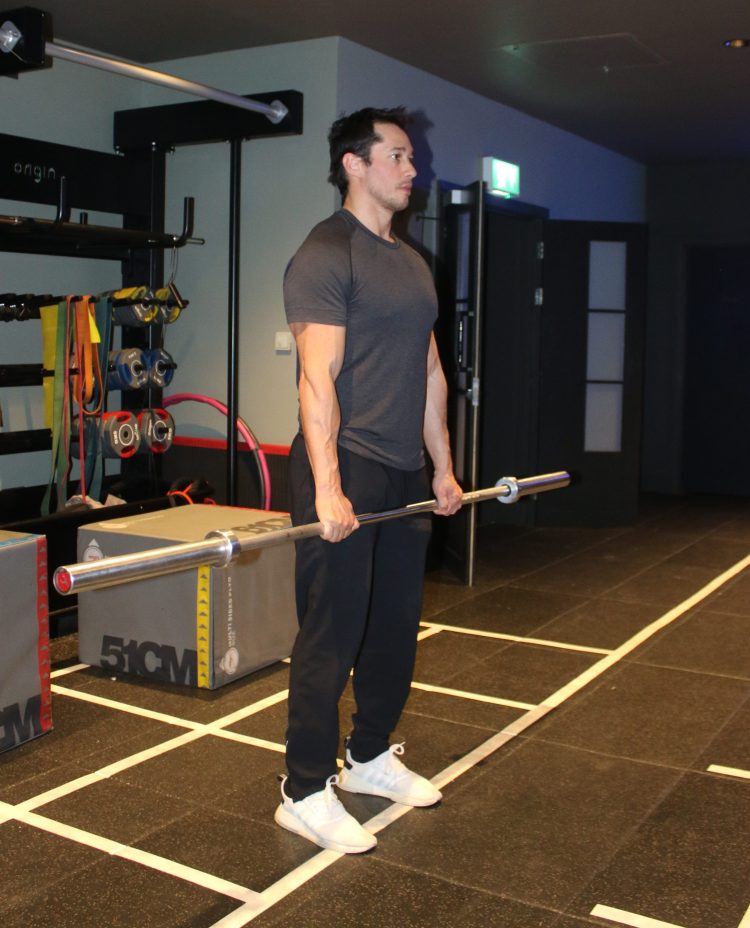
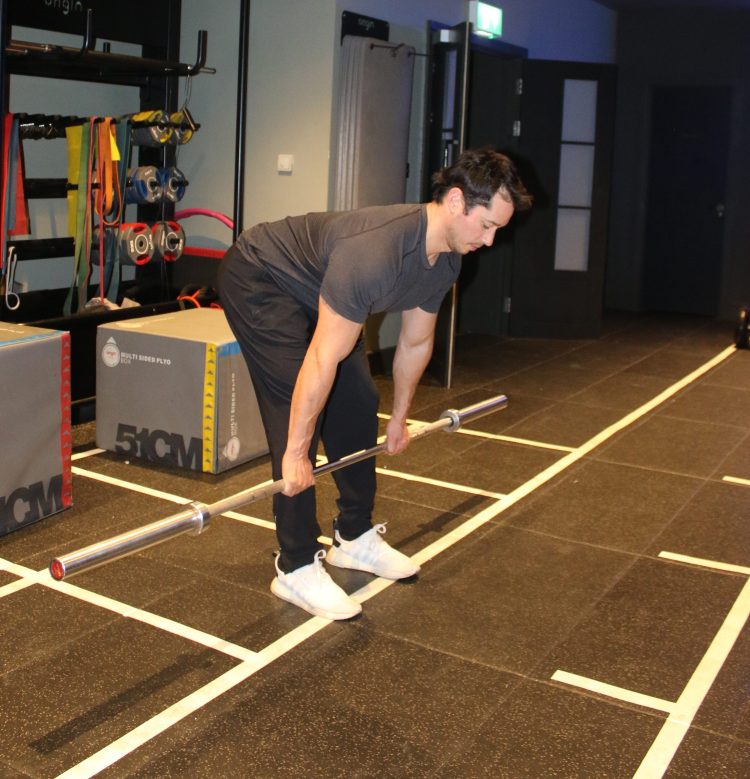
| Recommended reps | 8-12 |
| Recommended sets | 3 |
Why I like it: This is an exercise that works the lower back isometrically, targeting the lumbar extensor group. In the Romanian deadlift, the lower back muscles stabilise the spine through both the lowering and lifting phases of the lift. This is one of the best exercises not only for the lower back, but also to build muscle and strength in the hamstrings and glutes, which extend the hips in this exercise.
How to do it:
- Start with an upright posture holding the barbell with your arms straight and the bar in contact with your body
- Then, slightly bend your knees
- Now, slowly hinge your hips by pushing your hips backwards, keeping a strict neutral spine and without increasing knee bending
- Keep the bar in contact with your body
- Hinge only as far as your hips travel backwards
- Next, extend your hips by pushing them forward, focusing on squeezing your glutes muscles until you return to the upright start position
10. Deadlift
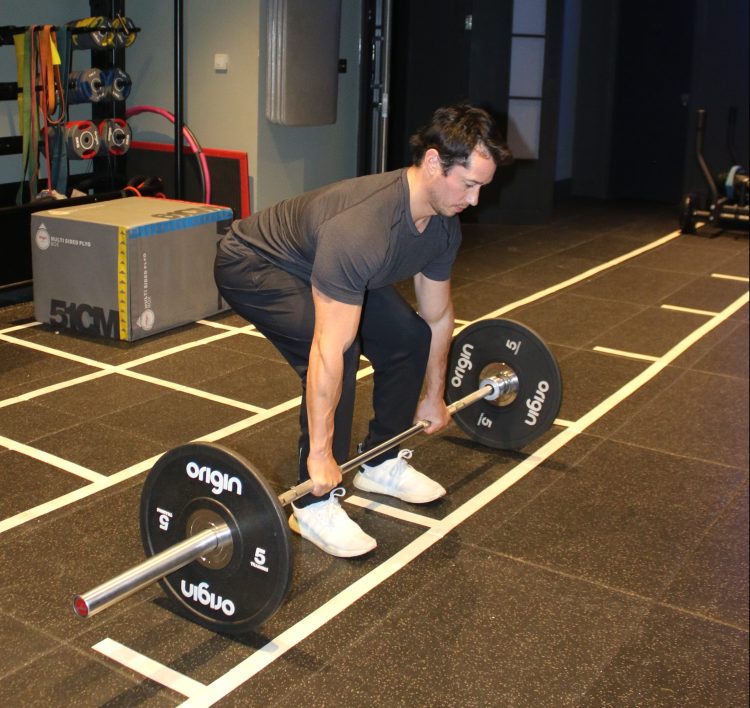
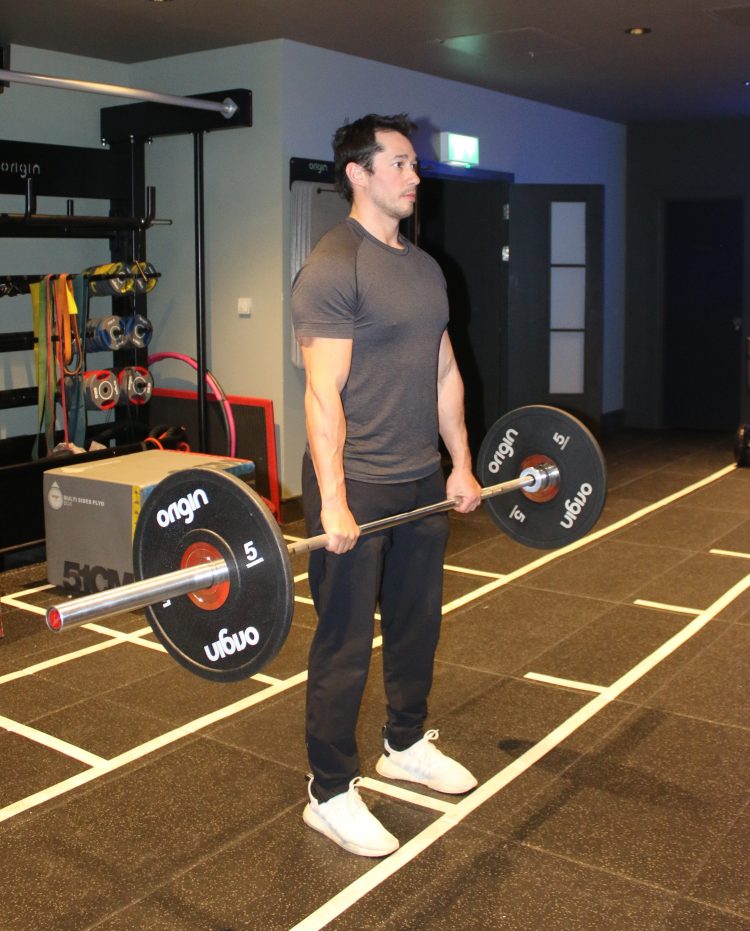
| Recommended reps | 6-10 |
| Recommended sets | 3 |
Why I like it: Similar to the Romanian deadlift, a convention deadlift works the extensor muscle group isometrically through spinal stability. Conventional deadlifts are a multi-joint exercise, therefore you get the added benefit of strengthening and developing a number of muscle groups, including the legs, back, glutes and hamstrings.
How to do it:
- Start with your feet shoulder-width apart and the bar pulled close to your shins
- Then, grasp the bar with an overhand grip just outside the shins
- With the bar grasped, hinge your hips by pushing them backwards
- Your shins should be vertical and hips lower than your shoulders
- Keep your head in a neutral position
- Just before lifting, engage your back (latissiumus dorsi) by thinking about ‘bending the bar’
- When lifting, push your feet into the floor to ‘drive the floor away’
- Next, push the hips forward and squeeze your glutes
- From the top position, hinge your hips backwards to lower the bar while maintaining a neutral spine
- Keep the bar in contact with your body
- When the bar reaches about knee height, bend the knees to return the bar to the ground
Why is it important to strengthen the lower back?
Building a strong, resilient lower back isn’t just about aesthetics; it’s about functional strength and injury prevention. The lower back plays a crucial role in providing support and stability for your core.
Here are some key reasons why adding lower back exercises to your fitness routine can take your strength and performance to the next level.
- Injury prevention: Strengthening your lower back muscles is like fortifying your body’s armor. A strong lower back reduces the risk of injury during everyday activities and workouts, especially when lifting heavy objects or performing dynamic movements.
- Enhanced performance: Whether you’re hitting the weights, running, or playing sports, a strong lower back can significantly improve your performance. It contributes to overall core strength, enhancing stability, power, and agility.
- Improved posture: Good posture isn’t just about looking confident; it’s crucial for spinal health. Strengthening the lower back muscles can help you maintain proper alignment, reducing the risk of back pain and enhancing your overall appearance.
- Core strength: Your lower back is a key player in the core. By strengthening these muscles, you’re boosting your core’s stability and functionality, which translates to improved balance and coordination.
- Pain-free living: Lower back pain is a common complaint, but it’s not inevitable. Strengthening your lower back can help alleviate existing pain and prevent future discomfort, allowing you to move smoothly and comfortably.
Incorporating targeted lower back exercises will enhance your physical performance and functionality. You’ll also cultivate a foundation of strength that supports you in all aspects of life.
Looking to kit your home gym out with a deadlift-ready barbell? This product from Strongway represents great value for money:

